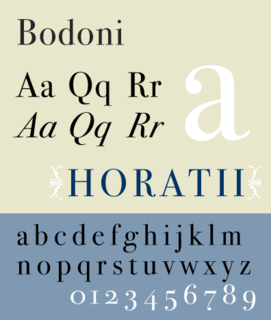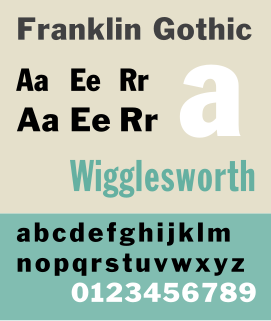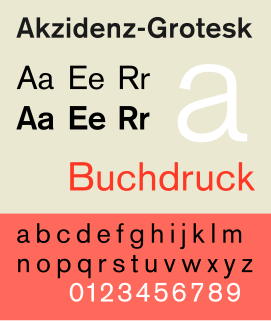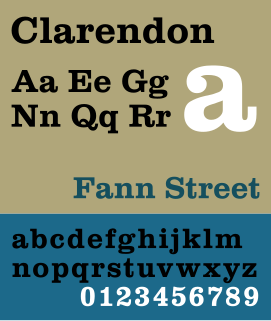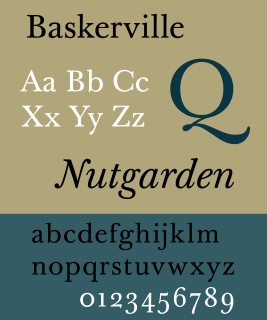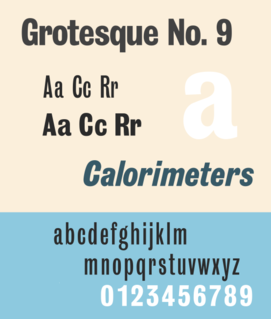
Walbaum is the name given to serif typefaces in the "Didone" or modern style that are, or revive the work of early nineteenth-century punchcutter Justus Erich Walbaum (1768 – 1837), based in Goslar and then in Weimar. [1] [2] [3] [4]
In typography, a serif is a small line or stroke regularly attached to the end of a larger stroke in a letter or symbol within a particular font or family of fonts. A typeface or "font family" making use of serifs is called a serif typeface, and a typeface that does not include them is a sans-serif one. Some typography sources refer to sans-serif typefaces as "grotesque" or "Gothic", and serif typefaces as "roman".

Didone is a genre of serif typeface that emerged in the late 18th century and was the standard style of general-purpose printing during the nineteenth. It is characterized by:

Punchcutting is a craft used in traditional typography to cut letter punches in steel as the first stage of making metal type. Steel punches in the shape of the letter would be used to stamp matrices into copper, which were locked into a mould shape to cast type. Cutting punches and casting type was the first step of traditional typesetting. The cutting of letter punches was a highly skilled craft requiring much patience and practice. Often the designer of the type would not be personally involved in the cutting.
Walbaum-style typefaces are "rational" in design, with minimal serifs and strong contrast between thin horizontal and thick vertical strokes, following the work of typefounders such as Firmin Didot and Giambattista Bodoni. [5] [6] [7] They are often used in publishing and remain very popular in Germany. Walbaum also designed fraktur blackletter typefaces, which (while not stylistically related) similarly have a structured and precise design. [8] [9] Walbaum sold the materials of his foundry to Brockhaus, who in turn sold them to the Berthold Type Foundry.
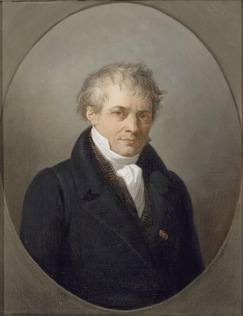
Firmin Didot was a French printer, engraver, and type founder.

Giambattista Bodoni was an Italian typographer, type-designer, compositor, printer and publisher in Parma.

Fraktur is a calligraphic hand of the Latin alphabet and any of several blackletter typefaces derived from this hand. The blackletter lines are broken up; that is, their forms contain many angles when compared to the smooth curves of the Antiqua (common) typefaces modeled after antique Roman square capitals and Carolingian minuscule. From this, Fraktur is sometimes contrasted with the "Latin alphabet" in northern European texts, which is sometimes called the "German alphabet", simply being a typeface of the Latin alphabet. Similarly, the term "Fraktur" or "Gothic" is sometimes applied to all of the blackletter typefaces.
In the twentieth century, Walbaum's type regained popularity through its sale by Berthold and copies were made by several companies. Digital revivals exist from František Štorm (in a release with optical sizes), Monotype (a 1933 version created for its hot metal typesetting system, and a separate digital version released in 2018), Berthold, Linotype and others. [10] [11] [12] [13]

František "Franta" Štorm is a Czech musician, photographer, typographer, writer, teacher, artist, illustrator and record producer, famous for being the vocalist and a founding member of the black metal band Master's Hammer.
Monotype Imaging Holdings, Inc. is a Delaware corporation based in Woburn, Massachusetts. It specialises in digital typesetting and typeface design as well as text and imaging solutions for use with consumer electronics devices. Monotype Imaging Holdings and its predecessors and subsidiaries have been responsible for many developments in printing technology—in particular the Monotype machine, which was the first fully mechanical typesetter, and the Linotype machine—and the design and production of typefaces in the 19th and 20th centuries. Monotype developed many of the most widely used typeface designs, including Times New Roman, Gill Sans, Arial, Bembo and Albertus.

In printing and typography, hot metal typesetting is a technology for typesetting text in letterpress printing. This method injects molten type metal into a mold that has the shape of one or more glyphs. The resulting sorts or slugs are later used to press ink onto paper. Normally the typecasting machine would be controlled by a keyboard or by a paper tape.


